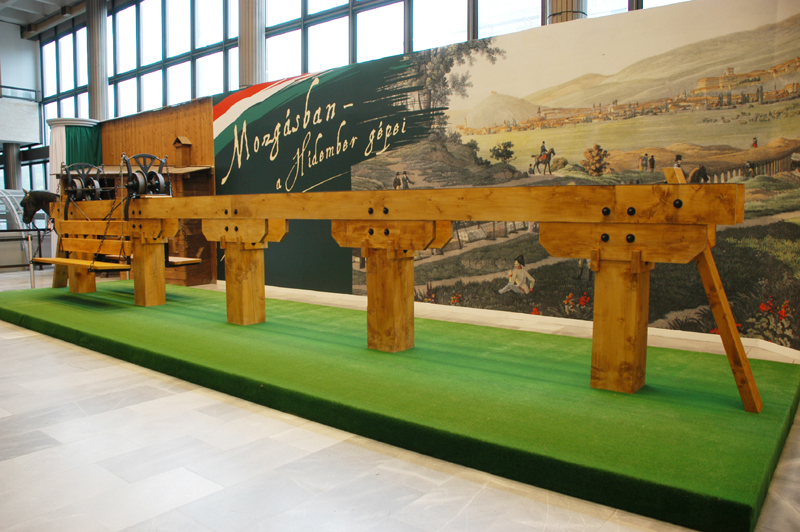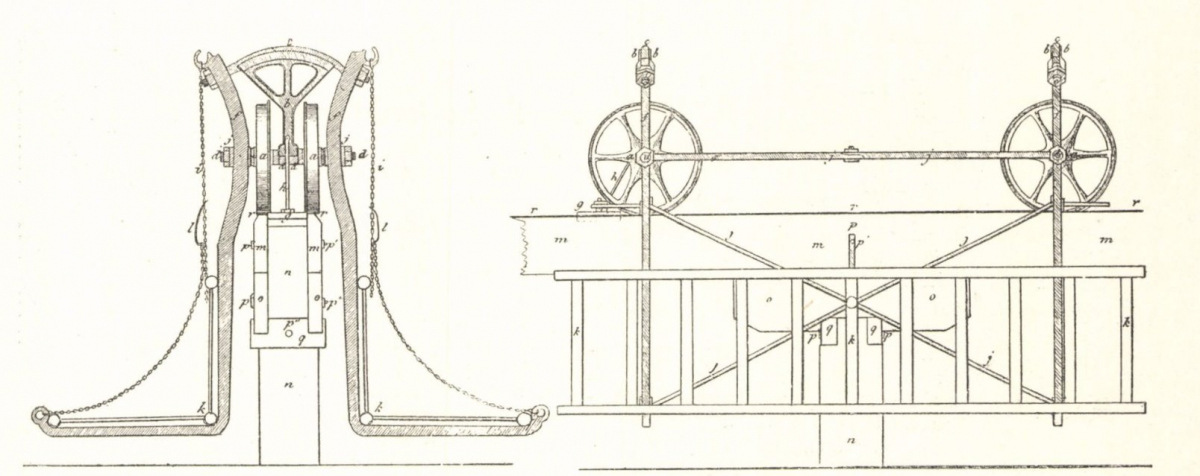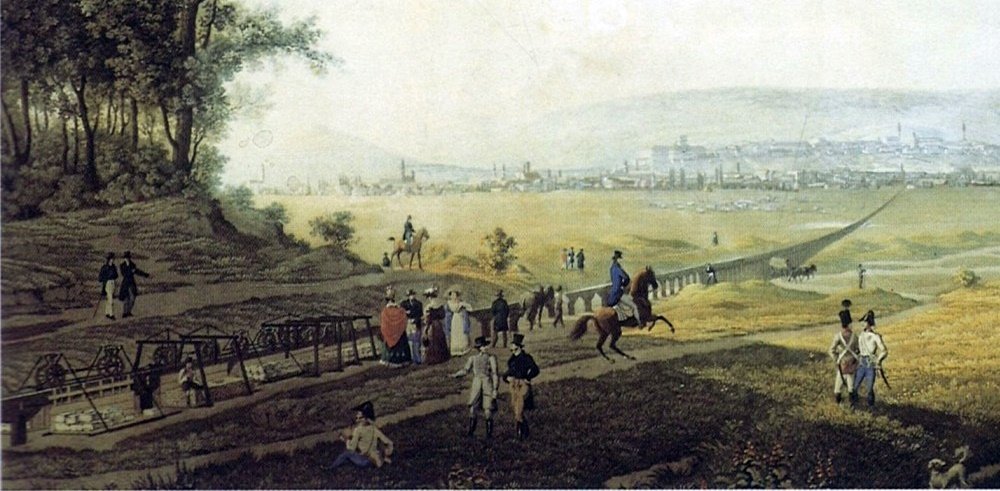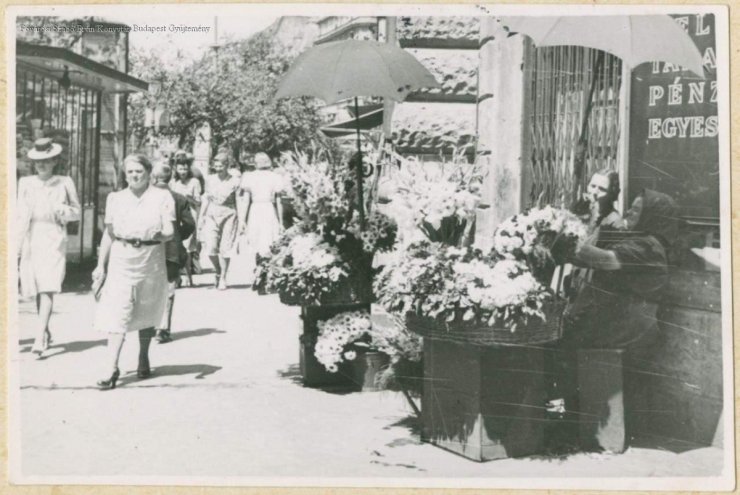The Pest-Kőbánya suspension railway was opened with a huge ceremony on 20 August 1827, the guest of honour was Palatine Joseph, one of the biggest supporters of the investment. The investors of the railway line leading from Pest, today's Baross Square, to Kőbánya, naturally hoped for profit and the right to cover the entire country with their railway line later. Illés Aladár Edvi, in his study of "Pest-Kőbánya trial railway I." (in issue 7 of 1895 of the Magyar Mérnök és Építész-Egylet bulletin) cites the call made by János Bodmer, which he wrote to the hopeful shareholders. It reads like this:
"In Hungary, one of the most important points to be connected would be the one that would connect Pest, the centre of the country, with Szolnok by road, because goods coming from Poland and the Russian Empire could arrive here on Tisza or the newly built road in Ungvár county; the noble wines of Hegyalja, the linen of Upper Hungary, all of these can be transported to the world market quickly and cheaply from here."
The first section - as a kind of test - was built up to Kőbánya. The Pest-Kőbánya route was ideal because the stones and bricks for the constructions in Pest were transported from Kőbánya, and by joining this stone transport business, the railway would have made a profit even on this short section of less than 7 and a half kilometres, according to the plans.

Reconstruction of a section of the railway in a previous 2011-2012 temporary exhibition of the Museum of Transport (Photo: MMKM)
Serious problems arose relatively quickly with the railway. The structure, which was based on the patent of János Bodmer, the director of the Baden salt mines, was significantly different from the way we imagine the railway today. The rails did not run on the ground, 1435 mm apart, but on beams laid on wooden posts, very close to each other, on the two edges of the beam, and their shape was more like a metal band, not the rails of today.
In the "regular" railway carriages used nowadays, the wheel is under the carriage, but in the Kőbánya suspension railway, the wheels were above the cars, the four wheels - 2 on each side - very close to each other rolled on the iron bands laid on the horizontal beams. Loads or passengers were accommodated in open structures hanging from the sides. The whole thing was drawn by horses, which of course walked on the ground. The idea was not completely unviable, according to reports from the time, a workhorse easily towed a 6-car, loaded assembly, which - converted to SI units - was nearly 14 tons including the weight of the cars.

The structure of the track (Illés Aladár Edvi: the Pest-Kőbánya trial railway I., Magyar Mérnök és Építész-Egylet bulletin, Issue 7 of 1895)
Problems arose at the very beginning of the whole undertaking because they could not keep the set construction cost of 20,000 HUF, which ended up being 31,000 HUF. New shares were issued, but not enough money came in anyway, and they owed nearly 5,000 HUF to master carpenter József Spiegel, the head of the construction, who took over the management of the construction after Bodmer's unexpected death in 1827.
The company would have been successful if it had continuously delivered building materials to Pest. However, it would have been necessary to successfully break into an already well-established, covered market, which would have been possible if the work was taken away from the competitors, who used to carry out the deliveries with carts, or the construction work in Pest should have been accelerated in such a way that the resulting excess capacity provides to all, old and new suppliers of building materials.
However, the constructions in Pest did not grow at the turn of 1827-1828, i.e., there was no need for such a large new transport capacity, so the transporters of that time, who feared for their livelihoods, naturally joined forces and significantly reduced their prices below the railway charges. In addition, the railway was not reliable, either due to the strong wind, when the cars swayed strongly, or due to other technical reasons, there were many downtimes. On the one hand, the screws broke off due to the natural drying and deformation of the wood, and on the other hand, the track was slippery due to the frost in winter. Since it was not possible to obtain hardwood during construction, the structure was built from pine. As early as the spring of 1828, it became clear that the entire line should be rebuilt and replaced with hardwood, and new, horizontal wheels should be placed in the cars, which would reduce the swaying.

The structure of the carriages (Illés Aladár Edvi: the Pest-Kőbánya trial railway I., Magyar Mérnök és Építész-Egylet bulletin, Issue 7 of 1895)
At the shareholders' meeting held on 20 March 1828, the situation was quite hopeless. The railway was already struggling with a debt amounting to 4,339 HUF 35 kreuzer, and it did not generate enough income to start making a profit. To hope for a profit, major improvements would have been necessary, for example, new cars would have had to be purchased. For the continued operation of the railway, and to have enough money for purchases, each shareholder should have had to pay an additional 15 HUF.
However, the shareholders no longer wanted to take on this burden, they believed that the company would not be profitable even if they paid this money, so they decided to close the business just a few months after the start. Following the decision of the shareholders, the track was dismantled after the Easter holidays, its material was sold to pay off the debt, and a report on the unsuccessful operation of the company was printed and distributed to the shareholders.
From the point of view of Pest, the suspension railway was important for several reasons. On the one hand, this investment also confirmed what was stated in law 10 years later, that Pest and Buda are the country's transport hub. The railway was based on the future hope that Pest is facing significant development, not only in the field of construction but also in the field of industrial plants, which require a large increase in land transport capacities. It is no coincidence that the railway was a trial section of a line extending to the Tisza and beyond to Debrecen - that is, from where it was not possible to transport by ship.
However, the railway was about 10 years ahead of its time. Think about it, until then, only one public railway line operated in one place in the world, England. The second such public railway line that could be used by anyone was the Pest-Kőbánya railway. Unfortunately, in 1827–1828, Pest did not yet require such transport capacity. However, it should also be added that this structure was not technically mature enough either.
Cover photo: A section of the railway on a contemporary engraving by János Hofbauer



































